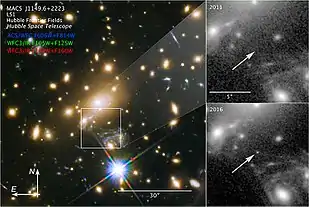K2-239
K2-239 (also designated EPIC 248545986) is a small red dwarf star in the constellation Sextans, about 49 parsecs (160 light-years) away from Earth. Observed by the Kepler Space Telescope during Campaign 14 of its K2 "Second Light" mission, it was found to have three hot, likely rocky Earth-sized planets in orbit around it.[2][4]
| Observation data Epoch J2000 Equinox J2000 | |
|---|---|
| Constellation | Sextans |
| Right ascension | 10h 42m 22.63s[1] |
| Declination | +04° 26′ 28.86″[1] |
| Apparent magnitude (V) | 14.549[2] |
| Characteristics | |
| Evolutionary stage | Main sequence |
| Spectral type | M3V[2] |
| Astrometry | |
| Proper motion (μ) | RA: −42.265[3] mas/yr Dec.: 3.976[3] mas/yr |
| Parallax (π) | 32.1414 ± 0.0851[3] mas |
| Distance | 101.5 ± 0.3 ly (31.11 ± 0.08 pc) |
| Details | |
| Mass | 0.40 ± 0.01[2] M☉ |
| Radius | 0.36 ± 0.01[2] R☉ |
| Luminosity | 0.016 ± 0.001[2] L☉ |
| Surface gravity (log g) | 4.9 ± 0.1[2] cgs |
| Temperature | 3420 ± 18[2] K |
| Metallicity [Fe/H] | -0.1 ± 0.1[2] dex |
| Other designations | |
EPIC 248545986 | |
| Database references | |
| SIMBAD | data |
Stellar characteristics
K2-239 is a small red dwarf star of spectral class M3V. It is 40% the mass and 36% the radius of the Sun with just 0.016 times the luminosity. It has a temperature of 3420 K and its age is unknown.[2] For comparison, the Sun has a temperature of 5778 K and is 4.5 billion years old. K2-239 has a visual magnitude of 14.549, far too dim to see with the unaided eye. It is also one of the closer systems found by Kepler, only about 160 light-years away from Earth.[2]
Planetary System
| Companion (in order from star) |
Mass | Semimajor axis (AU) |
Orbital period (days) |
Eccentricity | Inclination | Radius |
|---|---|---|---|---|---|---|
| b | 1.4 ± 0.4 M⊕ | 0.0441 ± 0.0008 | 5.240 ± 0.001 | — | 88.99 +0.68 −0.87° |
1.1 ± 0.1 R⊕ |
| c | 0.9 ± 0.3 M⊕ | 0.0576 ± 0.0009 | 7.775 ± 0.001 | — | 88.77 +0.70 −0.57° |
1.0 ± 0.1 R⊕ |
| d | 1.3 ± 0.4 M⊕ | 0.0685 ± 0.0012 | 10.115 ± 0.001 | — | 89.43 +0.38 −0.45° |
1.1 ± 0.1 R⊕ |
K2-239 has a system of three small, Earth-sized planets in a tight 2:3:4 orbital resonance chain. All of them are between 1.0 and 1.1 times the size of Earth, meaning they are very likely to be rocky. The discovery team estimated their masses to range from 0.9 M⊕ to 1.4 M⊕, consistent with a rocky composition for each of the planets. Due to their proximity to K2-239 they are all hot; however, because the host star is just 1.6% as luminous as the Sun, they are much cooler than if they were placed around our Sun. For albedoes of 0 they would have equilibrium temperatures of 502 K (229 °C; 444 °F) for K2-239b, 427 K (154 °C; 309 °F) for K2-239c, and 399 K (126 °C; 259 °F) for K2-239d. None of them are cool enough to host liquid water or be considered potentially habitable.
See also
References
- "EPIC ID 248545986". ExoFOP-K2. Retrieved 2018-06-19.
- Diez Alonso, E; Gonzalez Hernandez, J. I; Suarez Gomez, S. L; Aguado, D. S; Gonzalez Gutierrez, C; Suarez Mascareno, A; Cabrera-Lavers, A; Gonzalez-Nuevo, J; Toledo Padron, B; Gracia, J; de Cos Juez, F. J; Rebolo, R (2018). "Two planetary systems with transiting Earth-size and super-Earth planets orbiting late-type dwarf stars". Monthly Notices of the Royal Astronomical Society: Letters. 480 (1): L1. arXiv:1806.01181. Bibcode:2018MNRAS.480L...1D. doi:10.1093/mnrasl/sly102. S2CID 102334726.
- Brown, A. G. A.; et al. (Gaia collaboration) (August 2018). "Gaia Data Release 2: Summary of the contents and survey properties". Astronomy & Astrophysics. 616. A1. arXiv:1804.09365. Bibcode:2018A&A...616A...1G. doi:10.1051/0004-6361/201833051.
- Mike Wehner. "Astronomers spot a trio of Earth-sized planets orbiting a distant star". Retrieved 2018-06-19.

